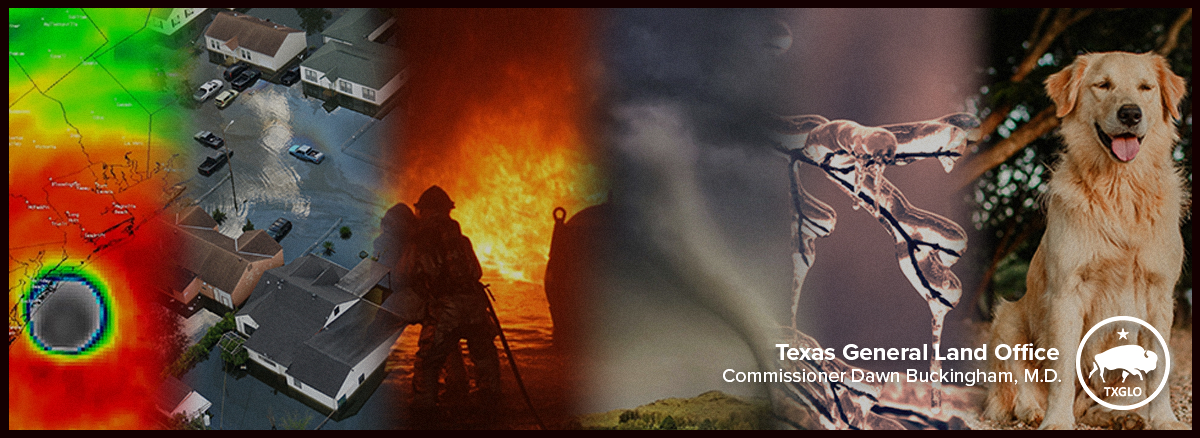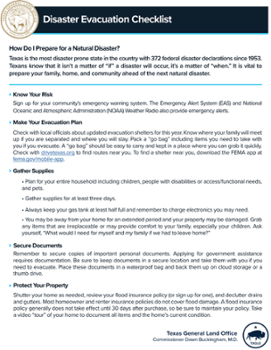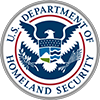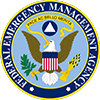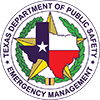Disaster Preparedness
Texas is the most disaster-prone state in the country with 372 federal disaster declarations since 1953. The Texas General Land Office (GLO) team works with local communities to encourage all Texans to protect their families and homes from natural disasters.
Download the GLO’s Disaster Evacuation Checklist to learn how to build an evacuation kit – or “go bag” – and be prepared for emergency situations.
Learn how to protect your home, safeguard your documents, prepare your emergency supplies, and make an evacuation route. Remember to review your flood and wind insurance policies or sign up for one. Texas storms, wildfires, tornadoes, and other disasters can be powerful, so we all must take steps to be prepared and stay prepared.
Recently, Commissioner Dawn Buckingham, M.D., announced a new baseball themed public outreach campaign with major league messages to keep Texans safe on and off the field this summer. Stepping up to the plate to join the lineup are a handful of first round draft picks including five of Texas’ all-star Abuelitas and pitchers Bobby Milacki and Jason Blanchard from the San Antonio Missions’ Copa de la Diversión (Fun Cup) team, the Flying Chanclas de San Antonio.
Dawn Buckingham, M.D., joined by some of Texas’ cutest kids, is reminding families that “Back to School” planning should also include being prepared for disasters. In a video release, Commissioner Buckingham helped children unpack a list of items they may need in case of an evacuation. The comical and educational video provides inspiration to help Texans build a family emergency go-bag when preparing students to head back to school.
Additionally, the Texas General Land Office continues to promote preparedness through “Don’t Ignore Your Risk,” a public outreach initiative to encourage Texans to be prepared and stay prepared for hurricane season. The multi-media, multi-platform public service announcement urges Texans to take time now to know their risk, purchase flood insurance, protect their home, safeguard documents, and prepare emergency supplies and an evacuation route.
Hurricane and Flooding Preparedness
- Protect your personal documents and special items.
- Build your disaster evacuation kit.
- Buy flood insurance.
- Flood proof your home.
- Develop a family evacuation plan.
Wildfire Preparedness
- Learn evacuation routes, practice with your household, and follow instructions from local authorities.
- Prepare for wildfires on your ranch and download the Wildfires and Your Livestock evacuation checklist.
- Protect your property, create a fire-resistant zone, and find an outdoor water source.
Tornado Preparedness
- Sign up for your community’s warning system and pay attention to local alerts.
- During a tornado warning, identify a sturdy shelter and go to the center or a small interior room.
- Do not enter damaged buildings until you are told they are safe.
Winter Preparedness
- Pay attention to weather reports and warnings of freezing weather and winter storms. Listen for emergency information and alerts.
- Gather supplies in case you need to stay home for several days without power. Keep in mind each person’s specific needs, including medication. Remember the needs of your pets. Have extra batteries for radios and flashlights.
- Only use generators and grills outdoors and away from windows. Never heat your home with a gas stovetop or oven.
Pet Preparedness
- Build a separate emergency evacuation kit for your animals.
- Bring copies of all registration papers, adoption information, and vaccination records.
- Make sure your pet is microchipped. Keep an inventory of livestock and make sure you have some type of identification.
Public Service Announcement (PSA) Videos and Kids Coloring Page
- Commissioner Dawn Buckingham Recruits the San Antonio Missions Baseball Team and a Roster of Abuelitas to Help Texans Be Prepared!
- Kids Hurricane Preparedness Go Bag Unboxing with Commissioner Dawn Buckingham
- Pet Preparedness Unboxing with Commissioner Dawn Buckingham
- Don't Ignore Your Risk - Flood Insurance (PSA)
- Build Your Go-Bag With Boone Kids Coloring Page
Weather Websites
- National Oceanic and Atmospheric Administration (NOAA) - https://www.noaa.gov/
- National Weather Service Safety Tips - https://www.weather.gov/safety/
- NOAA - Watches, Warnings or Advisories for Texas - https://alerts.weather.gov/cap/tx.php?x=1
- LCRA Flood Operations Report - https://floodstatus.lcra.org/
- Corpus Christi Weather - https://www.weather.gov/crp/
- Houston Weather - https://www.weather.gov/hgx/
- Brownsville Weather - https://www.weather.gov/bro/
- Lake Charles, LA (Southeast Texas) Weather - https://www.weather.gov/lch/
- U.S Geological Survey app to let users locate stream gauges and water conditions near them - https://www.usgs.gov/programs/groundwater-and-streamflow-information-program/streamflow-monitoring
Federal Disaster Assistance
Once there is a federal disaster declaration, residents of impacted counties can register for individual assistance by visiting https://www.disasterassistance.gov/ or calling 1-800-621-3362.
You can also email FEMA from the Disaster Assistance webform.
Resources
FEMA Disaster Recovery Center (DRC)
A Disaster Recovery Center (DRC) is a readily accessible facility or mobile office where applicants may visit for information about FEMA or other disaster assistance programs.
There are two ways to find a DRC near you:
- Use the DRC Locator to find addresses and DRC details. Find info like the hours of operation, services offered, and driving directions.
- Text DRC and a Zip Code to 43362. Example: DRC 01234. Using this option doesn’t add you to any messaging service. It’s just like doing a search on the Web. (Standard text rates may apply.)

